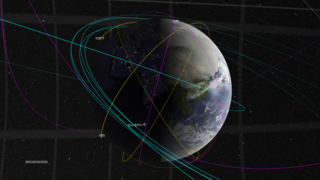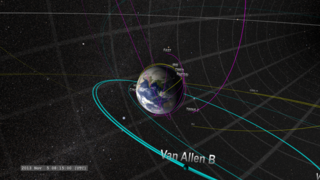Earth
Sun
Planets and Moons
Universe
ID: 4288
There've been a few changes since the 2013 Earth-Orbiting Heliophysics Fleet. As of Spring of 2015, here's a tour of the NASA Near-Earth Heliophysics fleet, covering the space from near-Earth orbit out to the orbit of the Moon.
Major changes with earlier versions:
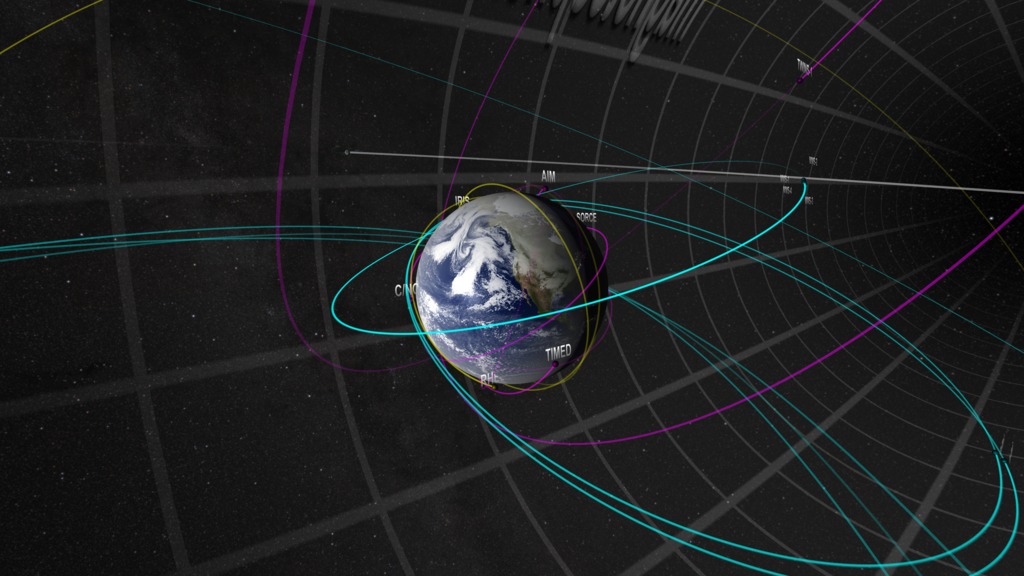


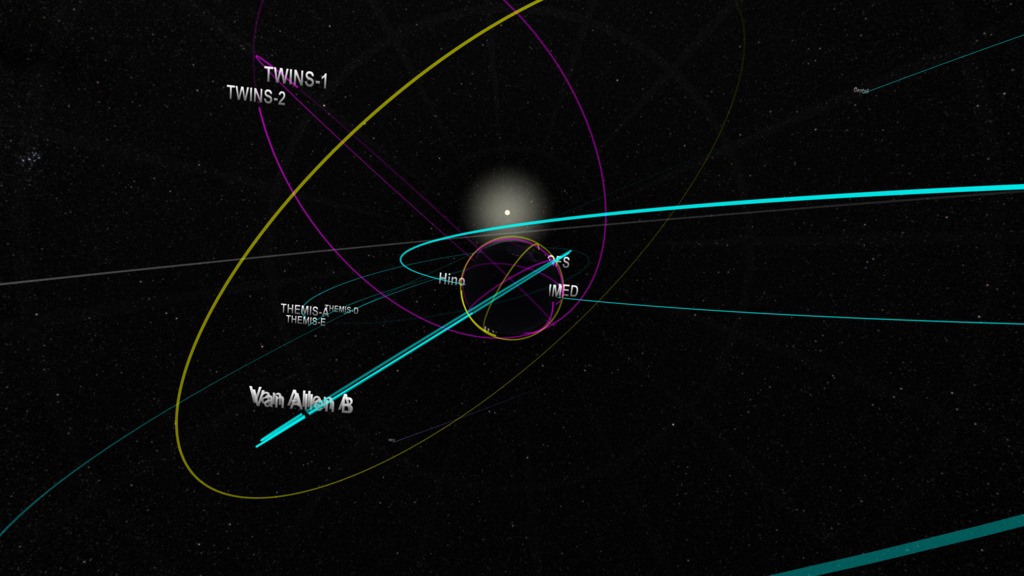



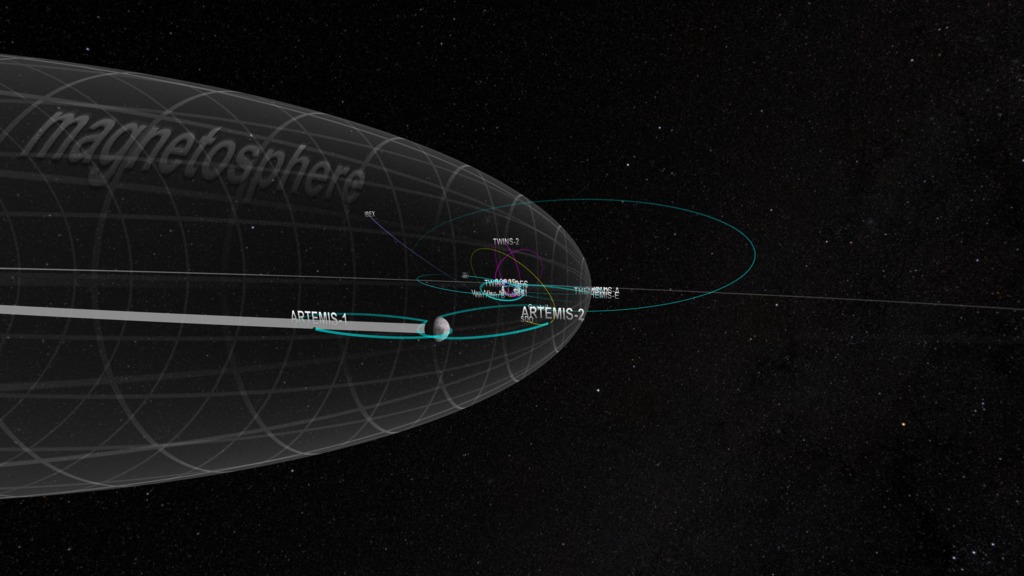

The 2015 Earth-Orbiting Heliophysics Fleet
There is a newer version of this story located here: https://svs.gsfc.nasa.gov/4589
The satellite orbits are color coded for their observing program:
Magenta: TIM (Thermosphere, Ionosphere, Mesosphere) observations Yellow: solar observations and imagery Cyan: Geospace and magnetosphere Violet: Heliospheric observations
Near-Earth Fleet:
- Hinode: Observes the Sun in multiple wavelengths up to x-rays. SVS page
- RHESSI : Observes the Sun in x-rays and gamma-rays. SVS page
- TIMED: Studies the upper layers (40-110 miles up) of the Earth's atmosphere.
- CINDI: Measures interactions of neutral and charged particles in the ionosphere.
- SORCE: Monitors solar intensity across a broad range of the electromagnetic spectrum.
- AIM: Images and measures noctilucent clouds. SVS page
- Van Allen Probes: Two probes moving along the same orbit designed to study the impact of space weather on Earth's radiation belts. SVS page
- TWINS: Two Wide-Angle Imaging Neutral-Atom Spectrometers (TWINS) are two probes observing the Earth with neutral atom imagers.
- IRIS: Interface Region Imaging Spectrograph is designed to take high-resolution spectra and images of the region between the solar photosphere and solar atmosphere.
Geosynchronous Fleet:
- SDO: Solar Dynamics Observatory keeps the Sun under continuous observation at 16 megapixel resolution.
Geospace Fleet:
- Geotail: Conducts measurements of electrons and ions in the Earth's magnetotail.
- Magnetospheric Multi-scale (MMS): This is a group of four satellites which fly in formation to measure how particles and fields in the magnetosphere vary in space and time. SVS page
- THEMIS: This is a fleet of three satellites to study how magnetospheric instabilities produce substorms. Two of the original five satellites were moved into lunar orbit to become ARTEMIS. SVS page
- IBEX: The Interstellar Boundary Explorer measures the flux of neutral atoms from the heliopause.
Lunar Orbiting Fleet:
- ARTEMIS: Two of the THEMIS satellites were moved into lunar orbit to study the interaction of the Earth's magnetosphere with the Moon.
Major changes with earlier versions:
- MMS added
- GOES satellites removed
- Cluster satellites removed
- Camera moves around the night-side of Earth .









Newer Version
Older Version
Visualization Credits
Tom Bridgman (Global Science and Technology, Inc.): Lead Animator
Scott Wiessinger (USRA): Producer
Genna Duberstein (USRA): Producer
Scott Wiessinger (USRA): Producer
Genna Duberstein (USRA): Producer
Please give credit for this item to:
NASA's Scientific Visualization Studio, the NASA/Goddard Satellite Situation Center, and Space Track.
NASA's Scientific Visualization Studio, the NASA/Goddard Satellite Situation Center, and Space Track.
Short URL to share this page:
https://svs.gsfc.nasa.gov/4288
Missions:
AIM
THEMIS and ARTEMIS
IBEX
Magnetospheric Multiscale (MMS)
Radiation Belt Storm Probes/Van Allen Probes - RBSP
SDO
THEMIS
Van Allen Probes
Data Used:
Note: While we identify the data sets used in these visualizations, we do not store any further details nor the data sets themselves on our site.
This item is part of this series:
Heliophysics Fleet
Keywords:
SVS >> Earth
SVS >> HDTV
SVS >> Moon
SVS >> Solar Wind
GCMD >> Earth Science >> Sun-earth Interactions
GCMD >> Location >> Magnetopause
SVS >> Space Weather
SVS >> Hyperwall
SVS >> THEMIS
SVS >> AIM
SVS >> SDO
SVS >> IBEX
SVS >> Solar Dynamics Observatory
SVS >> GOES
SVS >> Heliophysics
SVS >> Corona
SVS >> Satellite Orbit
SVS >> MMS
NASA Science >> Earth
NASA Science >> Sun
NASA Science >> Planets and Moons
NASA Science >> Universe
SVS >> RBSP
SVS >> Van Allen Probes
SVS >> Presentation
GCMD keywords can be found on the Internet with the following citation: Olsen, L.M., G. Major, K. Shein, J. Scialdone, S. Ritz, T. Stevens, M. Morahan, A. Aleman, R. Vogel, S. Leicester, H. Weir, M. Meaux, S. Grebas, C.Solomon, M. Holland, T. Northcutt, R. A. Restrepo, R. Bilodeau, 2013. NASA/Global Change Master Directory (GCMD) Earth Science Keywords. Version 8.0.0.0.0
https://svs.gsfc.nasa.gov/4288
Missions:
AIM
THEMIS and ARTEMIS
IBEX
Magnetospheric Multiscale (MMS)
Radiation Belt Storm Probes/Van Allen Probes - RBSP
SDO
THEMIS
Van Allen Probes
Data Used:
SSCweb also referred to as: SSCweb ephemerides
Ephemeris - NASA/GSFC Space Physics Data Facility
Satellite ephemerides
Space-Track Two-Line Elements also referred to as: Space-Track TLE
Ephemeris - NORAD
Satellite ephemerides
This item is part of this series:
Heliophysics Fleet
Keywords:
SVS >> Earth
SVS >> HDTV
SVS >> Moon
SVS >> Solar Wind
GCMD >> Earth Science >> Sun-earth Interactions
GCMD >> Location >> Magnetopause
SVS >> Space Weather
SVS >> Hyperwall
SVS >> THEMIS
SVS >> AIM
SVS >> SDO
SVS >> IBEX
SVS >> Solar Dynamics Observatory
SVS >> GOES
SVS >> Heliophysics
SVS >> Corona
SVS >> Satellite Orbit
SVS >> MMS
NASA Science >> Earth
NASA Science >> Sun
NASA Science >> Planets and Moons
NASA Science >> Universe
SVS >> RBSP
SVS >> Van Allen Probes
SVS >> Presentation
GCMD keywords can be found on the Internet with the following citation: Olsen, L.M., G. Major, K. Shein, J. Scialdone, S. Ritz, T. Stevens, M. Morahan, A. Aleman, R. Vogel, S. Leicester, H. Weir, M. Meaux, S. Grebas, C.Solomon, M. Holland, T. Northcutt, R. A. Restrepo, R. Bilodeau, 2013. NASA/Global Change Master Directory (GCMD) Earth Science Keywords. Version 8.0.0.0.0
